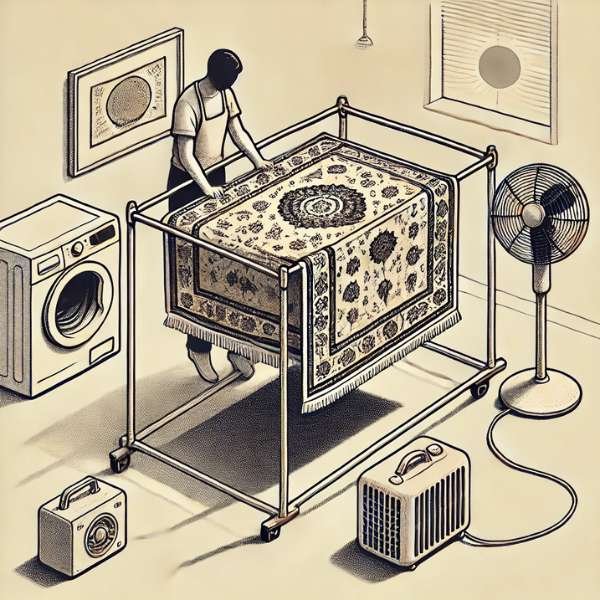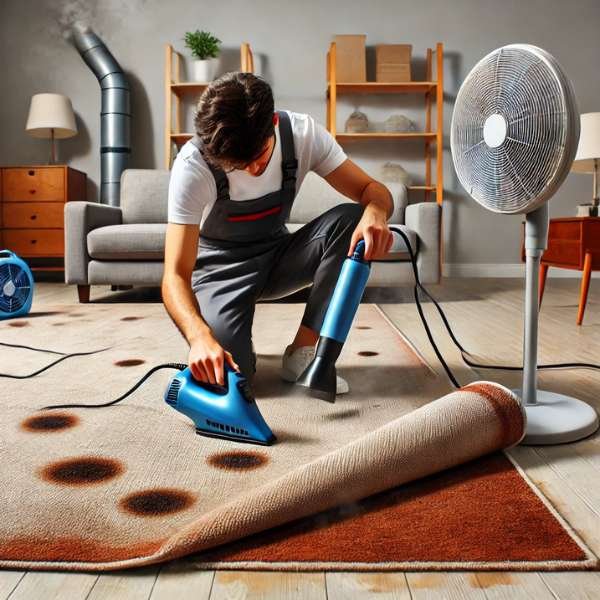Drying a big area rug at some point in winter can be a complicated challenge, especially while cold, damp situations make natural drying tough. Whether you have just cleaned your rug or it was given wet from snowy boots, finding the right drying approach is crucial to prevent mildew and preserve its high quality. In this manual, we’ll discover the pleasant strategies for how to dry a large area rug in winter, making sure your rug stays sparkling and harm-free even in the course of the coldest months. Stay tuned for professional hints with a view to making winter rug care less difficult!
Understanding the Nature of Winter Drying

Drying times stretch out significantly during the colder months due to lower temperatures and reduced humidity. Cold air retains less moisture than warm air, making it harder for the moisture trapped in your rug to evaporate quickly. If not handled correctly, your rug could remain damp for days, increasing the potential for mold or mildew growth. To make matters worse, certain winter drying mistakes—like leaving your rug in an unventilated room or near direct heat sources—can cause damage to the fibers, leading to warping or discoloration. Avoiding these common pitfalls will help keep your rug looking and feeling fresh.
Pre-Drying Preparations

Before diving into the drying process, it’s essential to thoroughly inspect your rug for any signs of moisture damage. Look for areas where the fibers appear discolored or where there is a musty odor, indicating the possible presence of mildew. Once your carpet passes inspection, clear a space inside your home that is suitable for drying. Ideally, the space should be free of clutter, well-ventilated, and far from direct heat sources that could damage the carpet. Gather all necessary tools, such as fans, dehumidifiers, and a wet/dry vacuum, to ensure you’re fully prepared.
Removing Excess Moisture Before Drying

Blotting and wringing out as much water as possible from your rug is the first and most crucial step. Use absorbent towels to blot the surface of the carpet, applying gentle pressure to avoid damaging delicate fibers. For larger amounts of water, a wet/dry vacuum is invaluable in pulling out the majority of moisture, reducing drying time dramatically. Rolling the carpet tightly and applying gentle pressure helps squeeze out the remaining water, leaving it ready for the next stage of drying.
Indoor Drying Options for Large Area Rugs

Creating an indoor drying station may sound complex, but it’s a straightforward process. Place your rug on a raised surface, such as a set of drying racks or sawhorses, ensuring that air can circulate freely around it. For maximum efficiency, set up portable fans around the carpet to encourage faster evaporation, while using a dehumidifier to draw excess moisture from the air. If your home has central heating, take advantage of it—positioning the carpet near but not directly on top of radiators or heating vents can help accelerate the drying process.
Using Natural Air Circulation to Dry Your Rug

Despite the chilly temperatures, natural air circulation can still work in your favor. Position your rug near open windows to benefit from any air movement, even if the breeze is cold. If you have sliding doors or windows that allow airflow without letting in too much cold, prop them open slightly to create cross-ventilation. Ensuring adequate air movement helps moisture escape, speeding up the drying process.
The Role of Sunlight in Winter Rug Drying

Though winter days may be shorter and the sun’s warmth less intense, sunlight can still be an ally in rug drying. On bright days, position your carpet near windows where sunlight streams through. Even indirect sunlight can make a noticeable difference in drying time. Creating a sunlit Evaporating area indoors helps harness those few precious rays to aid in moisture evaporation.
Using a Hair Dryer or Space Heater for Spot-drying

Occasionally, small sections of your rug may retain moisture despite your best efforts. In these cases, a hair dryer can be a quick and effective solution. Use the dryer on a low-heat setting to avoid damaging the fibers, and focus on specific damp spots until they’re dry. Alternatively, a space heater can be placed near the carpet, though care must be taken to avoid overheating the material, which could cause it to become brittle or faded.
Rotating Your Rug for Even Drying

As your rug dries, certain areas may dry faster than others due to varying airflow and temperature. Rotating the carpet every few hours helps ensure that no spot stays damp for too long. This simple technique prevents uneven drying and eliminates the risk of damp patches lingering beneath the surface.
Tackling Humidity Issues When Drying Indoors

High humidity levels can be a hidden culprit in prolonging the drying time of your area rug. Invest in a hygrometer to monitor the moisture levels in the air. If humidity becomes an issue, using a dehumidifier is key. This handy device works by extracting excess moisture from the air, making it easier for your carpet to dry without battling high ambient humidity.
To place a rug under a sectional sofa effectively, start by centering the carpet beneath the main seating area, ensuring all front sofa legs rest on the carpet for balance. When drying the rug indoors, tackle humidity issues by using a dehumidifier or fans to improve airflow. This prevents musty odors and helps maintain the carpet’s texture and longevity.
Utilizing a Laundry Drying Rack for Small Rugs

For smaller rugs, hanging them on a laundry drying rack is a practical option. Ensure the carpet is evenly draped across the rack so that air can circulate around all sides. Rotate and flip the carpet every few hours to prevent creasing and promote even Evaporating. This method works best when combined with fans or a dehumidifier in the room.
How to Dry a Large Area Rug in a Garage or Shed

A garage or shed offers a practical solution for drying large area rugs if indoor space is unavailable. Although colder, these areas can still be effective with the use of industrial fans or heaters. Elevating the carpet to promote airflow underneath and strategically positioning fans will help ensure an even Evaporating process.
Using a Rug Beater to Refresh Damp Rugs

Reviving a damp rug can be as simple as using a rug beater. Gently beating the carpet helps release trapped moisture, allowing for faster drying. It also serves to refresh the carpet’s texture, helping it maintain its plushness even after enduring a thorough Evaporating process.
Drying a Large Area Rug with Heated Flooring

Heated floors can be a wonderful tool for drying a big area rug effectively. Placing the carpet flat on a heated surface lets in the mild heat to promote moisture evaporation. Rotating the carpet periodically allows making certain even Evaporating and stops any spots from turning into too warm.
How to Deal with Stubborn Damp Spots

Occasionally, you may encounter spots on your rug that seem resistant to drying. Identify these areas early, and use focused Evaporating methods like a hair dryer or spot fans to tackle them. Stubborn damp spots can quickly become breeding grounds for mold, so addressing them promptly is essential.
Caring for Your Area Rug While Drying

Mold and mildew can wreak havoc on your rug during the drying process, particularly in winter when moisture lingers. Be proactive by keeping air circulating and monitoring the carpet regularly. To prevent heat damage, avoid exposing the carpet to direct heat sources for prolonged periods. Gentle care during drying will extend your carpet’s lifespan and preserve its appearance.
Emergency Drying Solutions for Unexpected Spills

Winter often brings unexpected challenges, like sudden spills that can soak into your carpet. Acting quickly is key—use towels to absorb as much of the spill as possible, then follow up with a wet/dry vacuum. Emergency Evaporating kits that contain absorbent powders or blotting cloths can also be helpful in these scenarios.
How to Tell When Your Large Area Rug is Fully Dry

Knowing when your rug is fully dry can be tricky. Run your hand over the surface to check for cool or damp areas, and press down to feel for any moisture beneath the surface. If the carpet feels cool to the touch or appears darker in certain spots, it may still be damp. Only once the entire carpet is warm and dry should you return it to its usual place.
Post-Drying Rug Care Tips

After your rug has dried, it’s time to give it a bit of extra love. Brushing the fibers can help restore their softness, while vacuuming will remove any dust or debris that settles during drying. To keep the carpet fresh, consider deodorizing it with a sprinkle of baking soda or a light spray of fabric refresher.
Storing Your Area Rug for Future Winters

Proper storage of your area rug after drying involves rolling it rather than folding it to prevent creases. Wrapping the carpet in a breathable material, such as cotton, offers protection against dust and moisture. Keeping it in a cool, dry location ensures the carpet stays safe from exposure to winter elements.
Conclusion
Drying a large area carpet in winter may seem challenging, but with the right techniques, it’s entirely manageable. Whether you use an indoor Evaporating rack, a dehumidifier, or utilize sunlight on clear winter days, you can ensure your carpet dries efficiently without damage. Always prioritize proper airflow and avoid high heat to maintain the rug’s integrity. By following these tips on how to dry a large area rug in winter, you can preserve its quality and enjoy a clean, fresh carpet throughout the colder months. For more home care tips, stay tuned to our blog and keep your living spaces cozy and well-maintained year-round!

